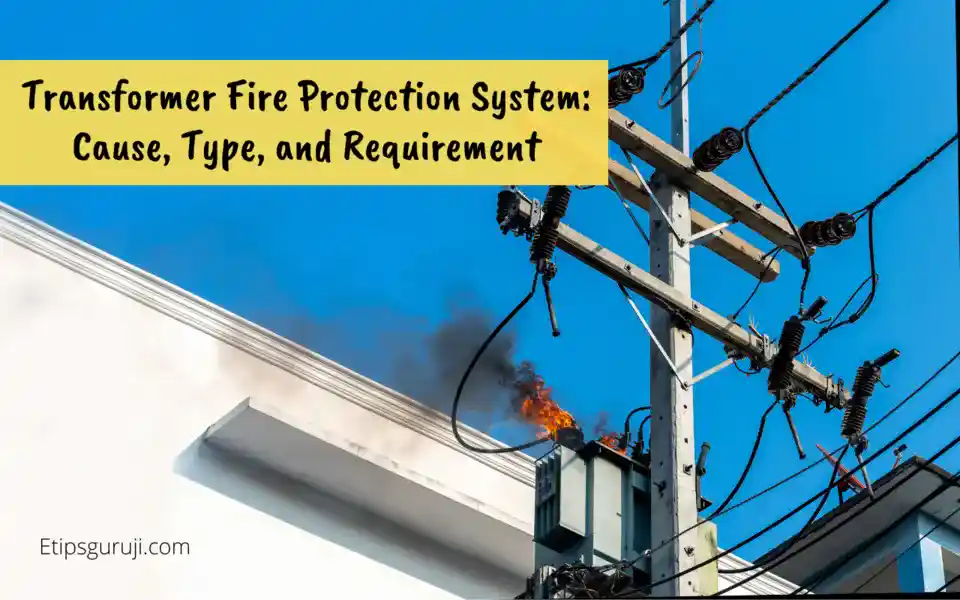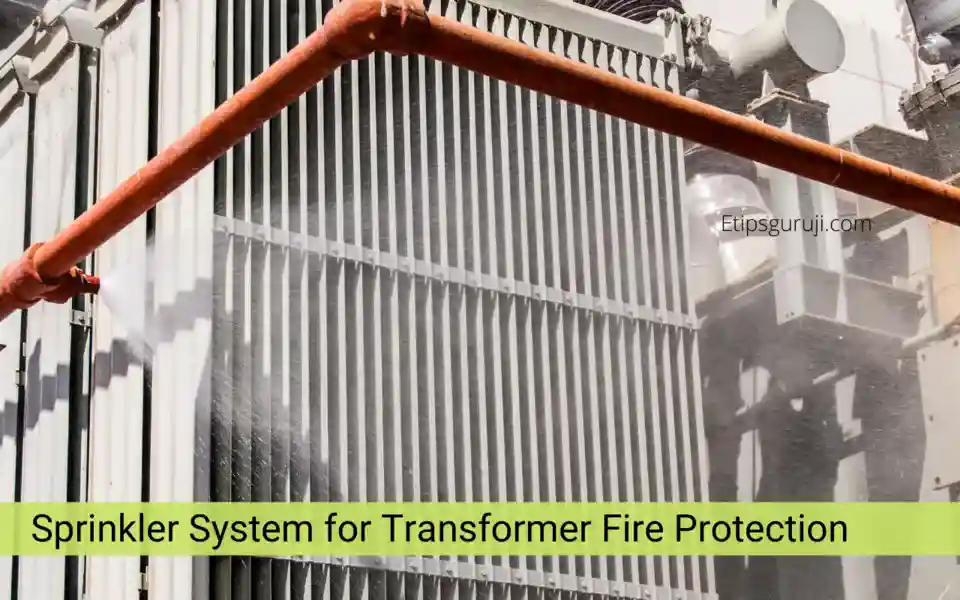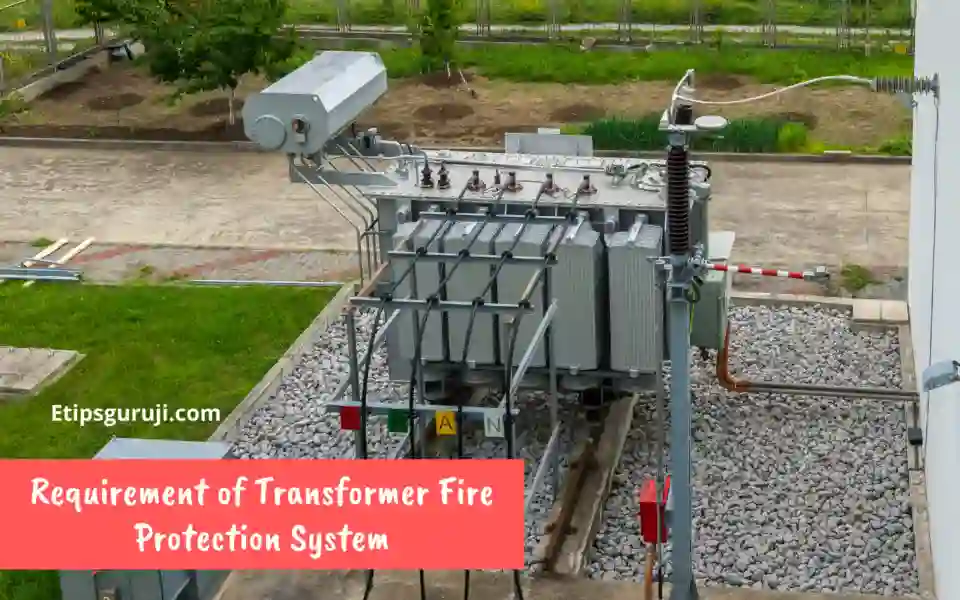Transformer Fire Protection System: Cause, Type, and Requirement

Fire protection systems are designed to detect and suppress fires. The system must be able to detect the fire and act quickly enough to suppress it before the fire spreads.
The type of fire protection system installed depends on the type of building, its use, construction materials, budget, and other factors.
Needs of Transformer Fire Protection System
A transformer fire protection system is the most important part of a transformer substation. It is designed to prevent any fire or explosion that can happen inside and outside the transformer.
The transformer fire protection system protects transformers from:
- Over-heating and Electrical Fires: Protect the fires from short circuits, overloads, lightning strikes on overhead lines, etc.
- Prevent Fire from Spreading: Prevent the spreading of fire to other parts of the transformer like oil tanks and switch gears as well as outside the transformer or building to other buildings.
- Minimizes the explosion: Prevent any damage to the surroundings from any possible explosion, especially when transformers are installed at ground level with open top covers or when neighboring buildings are within a certain distance from the transformer building.
- Neutralize the toxic gases and smokes: Even if the explosion triggers, the transformer fire protection system minimizes the release of toxic gases (majorly from the oil tank).
Types of Transformer Fire Protection Systems
The four main types of Transformer fire protection systems are:
1. Sprinkler System for Transformer Fire Protection

The sprinkler system uses pipes and valves installed in the transformer vaults to protect the equipment from fire and explosion. The water flow reduces the oxygen supply to the fire and cools the hot transformer oil and equipment.
They are capable to provide 10,000 gallons of water per minute at low pressure (usually less than 15 pounds per square inch).
There are two types of activation systems: automatic and manual methods.
- Automatic Activated Sprinkler system: Several sensors are installed around the transformer. Most of them activated above 80oC of temperature. While, some of them senses anomalies in the cooling oil tank such as short circuits, insulation breakdown, and leakage).
- Manual Activated System: No detecting sensors are installed. It was manually tripped by human involvement.
Note: Fire Wall and separation is one of the ideal tool that should be employed in every multiple transformer setup. As per NFPA 850 guidelines, recommend separation between two transformers is at least 5 feet which varies to 25 feet based on the oil capacity of the transformer.
2. Dry Chemical Fire Protection Systems for Transformer
In Dry chemicals such as carbon dioxide (CO2) or sodium bicarbonate (NaHCO₃) are used in this method of fire protection.
These chemicals work by lowering the temperature of the flame, preventing it from continuing to burn unless it is pumped with more fuel or oxygen from outside sources.
Dry chemical systems require routine maintenance because dust particles from the surrounding environment can clog them over time, reducing their effectiveness as a protection method.
3. Halon Fire Suppression System
In a Halon-based fire protection system for transformers, a gas called Halon (an odorless, colorless gas) is released which works by displacing oxygen in the air and cutting the fire risk.
However, Halon gas is now recommended and banned in American countries because it damages the ozone layer and even acts as a toxin if inhaled at a higher concentration.
4. Nitrogen Injection Fire Protection System for Transformer
Nitrogen injection fire protection system for transformer is a new type of fire protection technology.
The system works by injecting nitrogen gas into the transformer’s oil tank and its surrounding. Thus, no oxygen is available to burn which prevents extensive damage.
Advantages of Nitrogen Gas Injection than other conventional gas injection methods:
- No corrosion on the transformer case
- No change in the thermal expansion coefficient of oil
- Low-pressure drop.
- Effective in inducing cooling and extensively used in tropical and marine regions.
- Reliable for large industrial areas and loads.
- Relatively less maintenance is needed.
Requirement of Transformer Fire Protection System

Transformer protection is required when:
- Transformer terminal voltage is more than 2kV.
- Multiple transformers are separated by smaller distances.
- There is likely to be a fire on the premises, such as when flammable liquids are stored or handled.
- The transformer is located above ground where it is exposed to surrounding fires, such as at an industrial plant or a substation.
- The transformer contains hazardous substances that could be released into the environment if the transformer were damaged in a fire.
When Transformer Fire Protection System is Not needed?
Transformer protection is not always required, as there are some circumstances when we do not need to protect our transformers. These include:
- The voltage at the transformer terminals is less than 2 kV.
- Only single transformer setup.
- The transformer is used only for radio frequency circuits, where the maximum fault current may never exceed 10 kA.
CEA & NFPA Guidelines for Transformer Fire Protection System
The purpose of the CEA guide and NFPA is to provide general guidance for transformer fire protection.
Both the guidelines for transformer fire protection are essential for the safety of the general public. A document that outlines the standards and recommendations on how to plan and design transformer installations.
The CEA and NFPA guidelines are developed as part of the National Electrical Code, which is a national standard governing electrical installation practices in the United States, that every transformer needs to meet in order to be considered safe.
The guidelines cover a variety of topics, such as:
- Type of insulation that should be used
- Material
- Location
- How much space should be left around transformers?
- How they should be installed in relation to buildings and other structures?
- Equipment required to protect transformers
- Regular site visits for inspection
- Guidelines and required equipment for using transformers in extremely cold regions in the US.
Read More:
